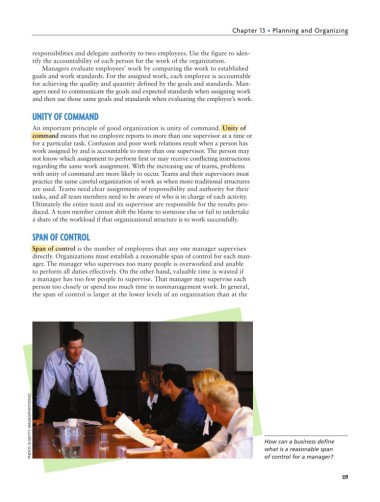Page 352 - Business Principles and Management
P. 352
Chapter 13 • Planning and Organizing
responsibilities and delegate authority to two employees. Use the figure to iden-
tify the accountability of each person for the work of the organization.
Managers evaluate employees’ work by comparing the work to established
goals and work standards. For the assigned work, each employee is accountable
for achieving the quality and quantity defined by the goals and standards. Man-
agers need to communicate the goals and expected standards when assigning work
and then use those same goals and standards when evaluating the employee’s work.
UNITY OF COMMAND
An important principle of good organization is unity of command. Unity of
command means that no employee reports to more than one supervisor at a time or
for a particular task. Confusion and poor work relations result when a person has
work assigned by and is accountable to more than one supervisor. The person may
not know which assignment to perform first or may receive conflicting instructions
regarding the same work assignment. With the increasing use of teams, problems
with unity of command are more likely to occur. Teams and their supervisors must
practice the same careful organization of work as when more traditional structures
are used. Teams need clear assignments of responsibility and authority for their
tasks, and all team members need to be aware of who is in charge of each activity.
Ultimately the entire team and its supervisor are responsible for the results pro-
duced. A team member cannot shift the blame to someone else or fail to undertake
a share of the workload if that organizational structure is to work successfully.
SPAN OF CONTROL
Span of control is the number of employees that any one manager supervises
directly. Organizations must establish a reasonable span of control for each man-
ager. The manager who supervises too many people is overworked and unable
to perform all duties effectively. On the other hand, valuable time is wasted if
a manager has too few people to supervise. That manager may supervise each
person too closely or spend too much time in nonmanagement work. In general,
the span of control is larger at the lower levels of an organization than at the
PHOTO: © GETTY IMAGES/PHOTODISC. How can a business define
what is a reasonable span
of control for a manager?
339

